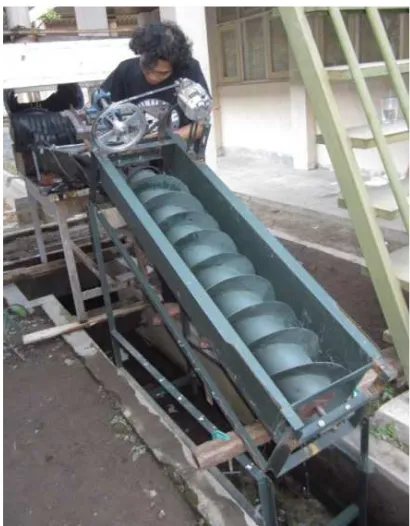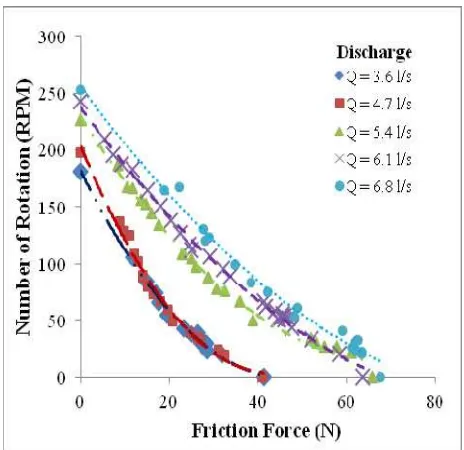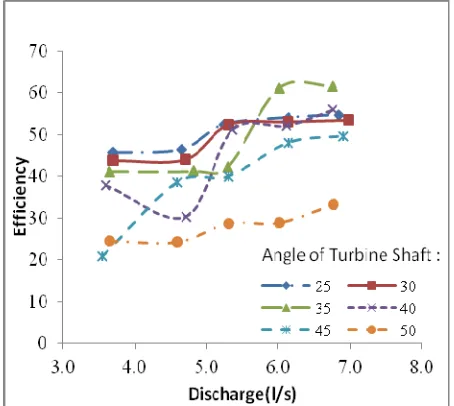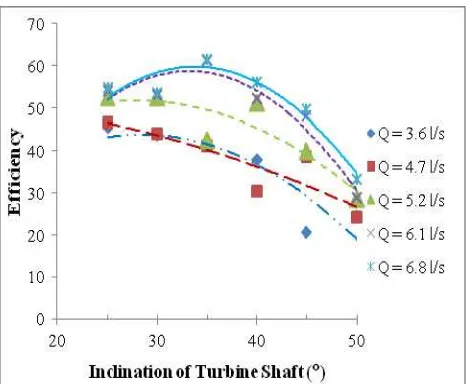E
FFECT OF
F
LOW
D
ISCHARGE AND
S
HAFT
S
LOPE OF
A
RCHIMIDES (SCREW)
T
URBIN
ON
T
HE
M
ICRO-
H
YDRO
P
OWER
P
LANT
P
ENGARUHD
EBITA
LIRAN DANK
EMIRINGANP
OROST
URBINU
LIRPADA
P
EMBANGKITL
ISTRIKT
ENAGAM
IKRO-H
IDRO
Bambang Yulistiyanto 1), Yul Hizhar 2), and Lisdiyanti 3) 1)
Lecturer, Civil Engineering and Environmental Department, Faculty of Engineering, Gadjah Mada University, e-mail: [email protected]; [email protected] 2)
Master Program of System Engineering of Energy, Faculty of Engineering, Gadjah Mada University, e-mail: [email protected]
3)
Master Program of System Engineering of Energy, Faculty of Engineering, Gadjah Mada University; Lecturer at SMP N 1 Galur, Kulon Progo, e-mail: [email protected]
ABSTRACT
A renewable energy source for mini / micro hydro usually exploits the potential energy of water flow that have certain head and the specific discharge which is converted into electrical energy through a turbine and generator. However, in many rivers, the average of water resource potential has a large discharge and low head. Thus, the development of a low head turbine or a very low head is very suitable to be developed in Indonesia. Screw turbine uses low head and high flow rate of water to generate torque and rotation as mechanic energy. Screw turbine has many advantages such as simple in construction and installation, low cost in operating and maintenance, and fish-friendly. The influencing parameters to mechanics performance of screw turbine are pitch distance, water discharge and the shaft slope. The objective of this research is to investigate the effect of shaft slope angle and discharge variations to mechanics performance of a 2-blades screw turbine in laboratory scale. A model used in the research was a 2-blades screw turbine, pitch (distance of a screw wave) is 1.6 Ro, external radius (Ro) is 0.1419 m, and internal radius (Ri) is 0.0762 m. The screw turbine was tested in Hydraulic Laboratory of the Vocational School of Civil Engineering, Gadjah Mada University, with various average discharges of water was about 0.00364 m3/s to 0.00684 m3/s, and the angle of turbine shaft slope was from 25°to50°. The result of the testing showed that the discharge and turbine shaft slope affected the turbine power and efficiency. The highest turbine power and efficiency were produced at average discharge was 0.00684 m3/s. The optimum screw turbine shaft slope was 35o, indicated by the output power of screw turbine of 16.231 watt and the efficiency of 61.61%.
Keywords: screw turbine, low head, discharge, shaft slope, turbine power, turbine efficiency
ABSTRAK
Sebuah sumber energi terbarukan untuk mini/mikro hidro biasanya memanfaatkan energi potensial aliran air yang memiliki head dan debit tertentu dikonversikan menjadi energi elektrik melalui sebuah turbin dan generator. Namun, pada umumnya sungai-sungai memiliki debit besar dan head rendah. Oleh karena itu, pengembangan sebuah turbin head rendah atau head sangat rendah sangat cocok dikembangkan di Indonesia. Turbin ulir menggunakan head rendah dan debit tinggi untuk menghasilkan torsi dan rotasi sebagai energi mekanik. Turbin ulir memiliki beberapa keuntungan seperti kemudahan dalam konstruksi dan instalasi, biaya pengoperasian dan perawatan yang rendah, dan fish-friendly. Parameter-parameter yang berpengaruh terhadap kinerja mekanik sebuah turbin ulir adalah jarak pitch, debit air, dan kemiringan poros turbin. Penelitian ini bertujuan untuk mengetahui pengaruh variasi kemiringan sudut poros dan debit terhadap kinerja mekanik turbin ulir 2 sudu dalam skala laboratorium. Sebuah model yang digunakan dalam penelitan ini adalah sebuah turbin ulir 2 sudu, pitch (jarak sebuah gelombang ulir) adalah 1.6 Ro, jari-jari luar (Ro) adalah 0.1419 m, dan jari-jari dalam (Ri) adalah 0.0762 m. Pengujian turbin ulir dilakukan di Laboratorium Hidrolika Sekolah Vokasi Teknik Sipil, Universitas Gadjah Mada, dengan variasi debit air dari 0.00364 m3/s hingga 0.00684 m3/s, dan variasi sudut kemiringan poros turbin ulir adalah dari 25° hingga50°. Hasil pengujian menunjukkan bahwa debit dan kemiringan sudut poros turbin mempengaruhi daya dan efisiensi turbin ulir. Daya dan efisiensi turbin tertinggi dihasilkan pada debit rata-rata 0.00684 m3/s. Kemiringan optimum turbin ulir adalah 35o, ditunjukkan oleh daya output seharga 16.231 watt dan efisiensi sebesar 61.61%.
Kata-kata Kunci: turbin ulir, head rendah, debit, kemiringan poros, daya turbin, efisiensi turbin
INTRODUCTION
Indonesia is a rich country of potential renewable energy sources such as mini / micro hydro as water energy or hydro po- wer. The development of hydro power usually exploits the poten-tial energy of water flow that have certain head and the specific discharge, which is converted into electrical energy through a turbine and generator. In many places, the average of water resource potential has a large discharge and low head. Thus, a low head turbine is very suitable to be developed in Indonesia. Screw turbine is kind of the turbine that can be operated by using low head and high discharge. Screw turbine has low angular velocity. This turbine has several advantages among other types
LITERATURE REVIEW
Archimedes screw is a type of screw that has been known since ancient times and has been used as pumps for irrigation in the park in Babylon. Along with the energy crisis that occurred in the world and the limited potential of water energy source that requires high head, then started in the year 2007, an engineer suggested the idea to invert the rotating screw pumps and then let the water pump is mounted below a generator then the electricity will be generated (Arismunandar, 1997; Havendri and Arnif, 2010). In principle, the screw turbine is a reversal of the screw pump function itself. Rorres (1998) and Paish (2009) stated that the geometry of an Archimedes screw (screw pump) is determin-ed by several external parameters, which are the outer radius of the screw, total screw length, and slope. Other parameters that af-fect the internal parameters such as the inner radius, the number of blades, and blade pitch. External parameters are usually determined by the placement of Archimedes screw locations and how much water to be removed. While the internal parameters are freely determined to optimize the performance of the screw.
According to the FAO Corporate Document Repository, the Archimedean screw pump is a pump oldest ever existed since people pay attention to fluid removal. However, this type of mp is still widely used because of several advantages. These pu-mps can work at its optimum at the installation angle of 30° to 40°. The working principle of the Archimedean screw turbine is a reversal of the pump hydrodynamic Archimedean where these turbines harness water flow energy into mechanical energy.
Leclerc, (2007), argued that the turbine with low head has a great potential to develop renewable energy and environmentally-friendly technology. By using this low head turbine, it will reduce the civil works, easy in system installation, and low cost in operation and maintenance. Archimedes Screw-typed turbines are especially suited to sites with high flows (200 liters/sec to 6000 liters/second) and work economically with head levels from 1 to 10 meters (i.e. very low is still useful) (Senior At.all., 2010). Future Energy Yorkshire (FEY) has carried out a study on the relative costs of an Archimedes’ screw and the more common Kaplan turbine for a small scale hydropower site, and showed a strong cost advantage for the Archimedes’ screw comparing with the one of Kaplan turbine. For an energy output of about 15% more, the Archimedes’ screw cost about 10% less.
Efficiency of the screw turbine is defined as η= Pt/Pf .
100%, where Pt is turbine output power and Pf is hydro power. The hydro power depends on the discharge and the head of water flow (Munson, B. R., et.al, 2005), calculated as Pf = ρ.g.Q.H,
whereas the output power can be defined by using the following equation: Pt = T(2πN/60). In that equation T is a torque, obtained
from experiments at a laboratory.
The torque of screw turbine, T is obtained from turbine tangential force, Ft multiply the torque radius, r.
RESEARCH METHODOLOGY
The experiment was conducted at Hydraulics Laboratory of the Vocational School of Civil Engineering, Gadjah Mada Uni-versity.
The main equipments used in this study are: 1. A 2-blades screw turbine model (pitch = 1.6Ro).
2. Tachometer to measure the angular velocity of the turbine. 3. V-notch to measure the water flow discharge.
The parameters used in this research are divided into: a. Independent variables, consists of water discharge (Q) and
turbine slope angle (è).
b. Dependent variable, consist of rotational speed (n), torque (T),
hydro power (Pf), output turbine power (Pt), and turbine
efficiency (ç), (Sularso and Suga, K., 1985).
Figure 1 presents the design of screw turbine which was built in the laboratory. The sizes indicated in the figure are in mm.
Figure 1. Design of screw turbine
The screw turbine was mounted in the frame which its position is schematized in the Figure 2.
Figure 2. Installation of Screw Turbine
RESULTS AND DISCUSSION
Relation between Water Discharge (Q) and Turbine Rotation Speed (n)
The instrument used to measure the rotational speed of the turbine shaft is tachometer. Figure 3 shows the relation between water discharge (Q) and turbine rotation speed (n) for all values of turbine shaft slope (è).
Figure 3 shows that turbine rotational speed is higher at shaft slope 30o and 40o, especially for high water discharge. Based on Figure 3, the higher water discharge (Q), the higher turbine rotation speed (n) for all variation turbine shaft angle. This is because the current water contains energy. If the water current flows greater, so the mean energy possessed by the water flow is also become greater. In accordance with the law of conservation of energy, if the flow of water in the stream is passed through a turbine, then the water energy is converted into other energy forms one of which is turbine rotation. Therefore, greater water energy gives higher turbine rotation speed.
Experiments were also conducted to analyze the mechanical power of turbine by measuring torque, T that is the turning energy generated by the turbine shaft.
Figure 3. Relation between water discharge, Q and turbine rotation speed, n
Figure 4. Torque measurement scheme with braking mechanism
By adding a certain value of load as shown in Figure 4, and when the turbine spins, the rope will pull the spring scale. The breaking or friction force worked at the turbine is defined as the resultant between the load added and the force read at the spring scale.
The water flow rate passes, Q to the screw turbine were varied from 3.6 l/s to 6.8 l/s, with the turbine shaft inclined for 5 different angles from 25o to 50o. For each running, a series of loading were installed to break the pulley rotations. Numbers of turbine rotation were measured by using tachometer at each values of load. Figure 5 presents relation between friction force,
F and turbine rotation speed, n.
Figure 5 shows that giving friction force to the turbine pulley or turbine shaft will decrease the turbine rotation speed. The friction forces is then continued to be raised until the turbine stop spinning. The friction force equals to tangential force of the turbine.
Figure 5. Relation between friction force, F and turbine rotation speed, n
Using values of friction force (F) and its number of rotations (n), the torque acting on the turbine can be calculated by multiply this friction force, F with the radius of pulley, r. (Paryatmo, W., 2007)
T = F . r (1) The power of the turbine, Pt is then obtained from the torque,
T multiplied by the angular velocity, ω.
Pt = T . ω (2)
where ω = 2πn/60
Figure 4 can also be presented with the friction force, F as a quadratic function of the number of rotations, n.
F = f(n2) (3) By using this function, the power of turbine, Pt can be formulated as:
Pt = f(n 2
).r.2πn/60 (4.a)
Pt = f(n3) (4.b)
The above formulation represents the power produced by the turbine is a cubic function of the number of rotation. The power for the shaft slope angle equal to 40o, related to the number of turbine rotations for various values of discharge, are displayed in Figure 6. Results for the other inclinations are also found, but do not present in this paper.
In Figure 6, for each values of discharge and shaft in-clination of turbine, obtained certain values of number of turbine rotation which produce maximum power. These values of power are further used to be analyzed as a function of water discharge and shaft inclination of turbine. These are discussed as the fol-lowing. Figure 7 shows the relationship between discharge and turbine power for all values of turbine shaft slope.
Spring scales
Load
Figure 6. Relation between turbine rotation, n and turbine power, Pt
Figure 7. Relation between discharge, Q and turbine power, Pt
Figure 7 presents power produced by the turbine with various values of discharge and inclination of turbine shaft. The increasing of water discharge will produce the higher values of turbine power. It is also shown that for high water discharge, by installing the turbine shaft with inclinations 35, 40 and 45 degrees, produces higher turbine power compared with the other shaft inclinations. In the lower inclinations, the flow discharge pushes less forces, and at higher inclination, the water flow jumps when it passes through the beginning of the canal.
The potential water power passes through the turbine can be calculated with equation Pf = ρ.g.Q.H, where Q is the water
discharge and H is the kinetic head. The turbine efficiency can be determined as the following equation:
% 100 × =
f t P
P
η
(5)
Figure 8 informs the values of turbine efficiency as a fun-ction of water discharge and inclination of turbine shaft. The bine efficiency is reached a value of 60%. At inclination of tur-bine shaft equal to 50 degree, the value of efficiency is much less compared with other inclinations. This is due to the flow con-dition passed through the turbine, where at the edge of the inclined flume, the flowing water jumps and it does not push the turbine blades precisely. It reduces the water energy that can be converted into tortion energy (torque).
Figure 8. Relation between discharge, Q and turbine efficiency, ç
Effect of Turbine Shaft Slope Angle to the Turbine Power
Experiments were also conducted by using the slo-pe variation of turbine shaft to study the optimal value of inclina-tion of turbine shaft that produce the highest magnitude of turbi-ne power and its efficiency.
As previously discussed, experiments were carried out us-ing 5 variations of the slope of the turbine shaft, which is 25, 30, 35, 40, 45, and 50 degrees. Results of the experiments are presented in Figure 9, showing the turbine power produced which was installed with different inclination. It shows, the increase of values of shaft slope from 25 to 40 degrees give the raise of the turbin power. The increasing of the turbine power is more significant for the larger discharge. However, at higher values of shaft slope (45 and 50 degrees), the turbine power decrease for all values of water discharge.
Figure 9. Relation between inclination of turbine shaft,
è and its power, Pt
Based on the results presented in Figure 8, the efficiency of turbine corelated to the values of the inclination of the turbine shaft can be analized, give relations in Figure 10 as follows:
Figure 10. Relation between inclination of the turbine shaft, è
and its efficiency, ç
CONCLUSION
A model used in the research was a 2-blades screw turbine, pitch = 1.6Ro, external radius, Ro = 0.1419 m, and internal radius, Ri = 0.0762 m. The screw turbine was tested in Hydraulic
Laboratory of the Vocational School of Civil Engineering, Gadjah Mada University, with various average discharges of water was about 0.00364 m3/s to 0.00684 m3/s, and the angle of turbine shaft slope was from 25° to50°.
The result of the testing showed that the discharge and turbine shaft slope affected the turbine power and efficiency. The highest turbine power and efficiency were produced at average discharge was 0.00684 m3/s. The optimum screw turbine shaft slope was 35o, indicated by the output power of screw turbine of 16.231 watt and the efficiency of 61.61%.
ACKNOWLEDGMENT
The authors generously give acknowledgment to Ir. Suryo Darmo, M.T. dan Ir. Prajitno, M.T. for their valuable advices and intensive discussions.
REFERENCES
Anonim. (2010). Manufacturer of Screw Pumps and Small Hydro
Power Plants, http://www.simul.cz/dokumenty/prezentace_
hydro_2010.pdf
Arismunandar, W. (1997), Penggerak Mula Turbin, ITB, Ban-dung
Dietzel, F.(1996). Alih Bahasa Dakso Sriyono, Turbin, Pompa,
dan Kompresor, Erlangga, Jakarta.
Havendri, A. dan Arnif, I. (2010). “Kaji Eksperimental Penen-tuan Sudut Ulir Optimum pada Turbin Ulir untuk Data Pe-rancangan Turbin Ulir pada Pusat Listrik Tenaga Mikro-hidro (PLTMh) dengan Head Rendah.” Seminar Nasional Tahunan Teknik Mesin (SNTTM) ke-9, Palembang.
Leclerc, M., (2007), A New Turbine Low Head Profitable
Harne-ssing of Verry Low Head Applications, MJ2 Technologies,
France.
Munson, B. R., Young, D. F., Okiishi, T. H. (2005). Mekanika Fluida Jilid 2, Erlangga, Jakarta.
Paish, O. (2009). Small-Scale Hydro Feasibility Study, Final
Report Part C: Technology Review, Nidderdale Aonb,
http://www.nidderdaleaonb.org.uk
Paryatmo, W. (2007). Turbin Air, Graha Ilmu, Yogyakarta. Rorres, C. (1998). The Turn of the Screw: Optimal Design of An
Archimedes Screw, Journal of Hydraulic Engineering,
Phila-delphia.
Senior, J., Wiemann, P., Muller, G. (2010). The Rotary Hydraulic
Pressure Machine for Very Low Head Hydropower Sites,
Journal of Civil Engineering Department, University of Southampton, U.K.
Sularso & Suga, K. (1985). Dasar Perencanaan dan Pemilihan



